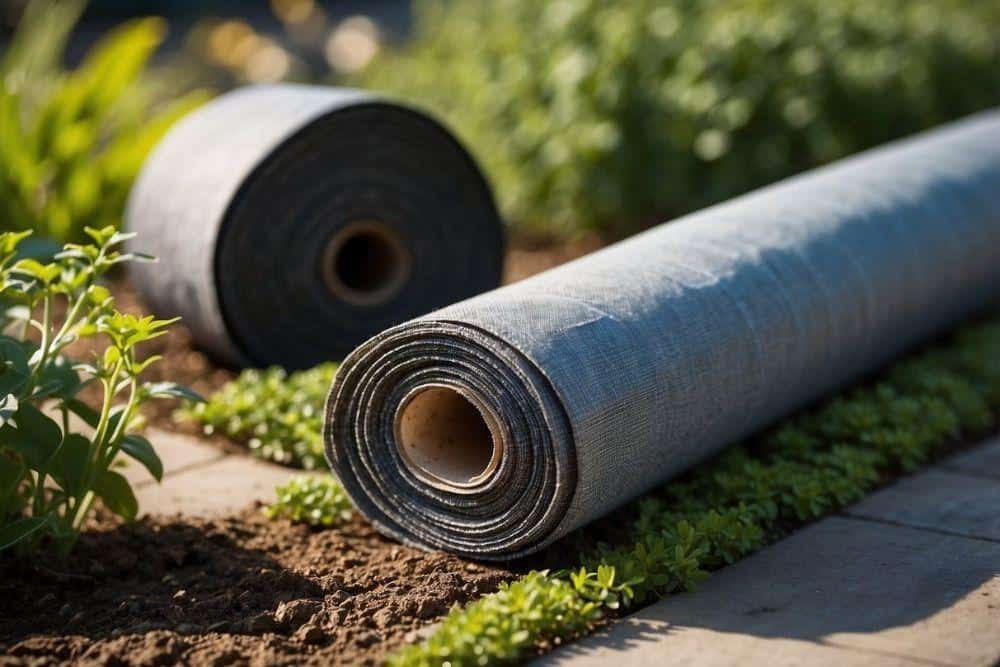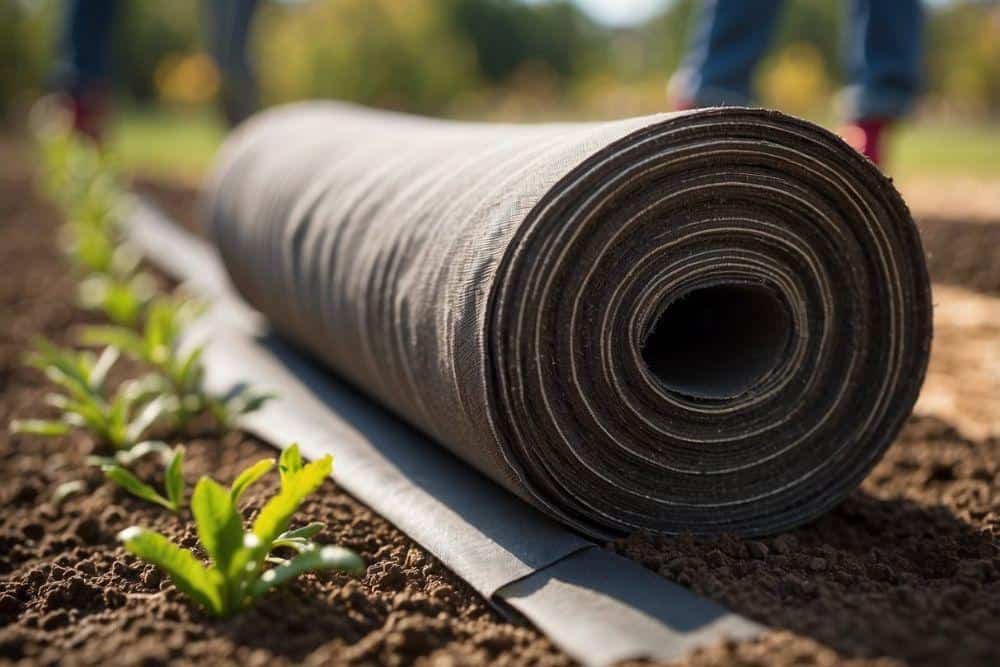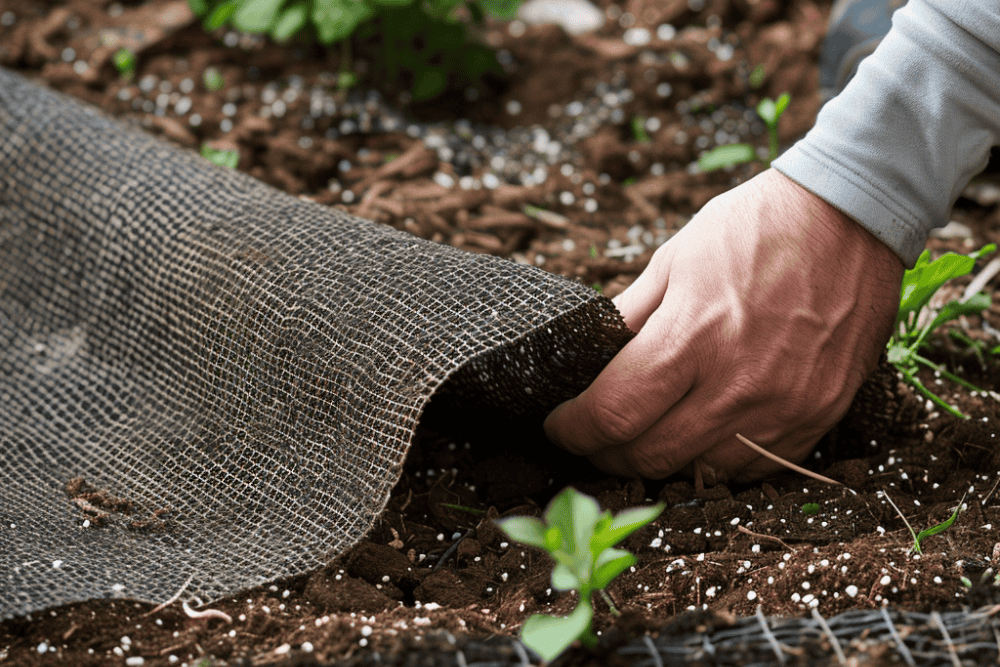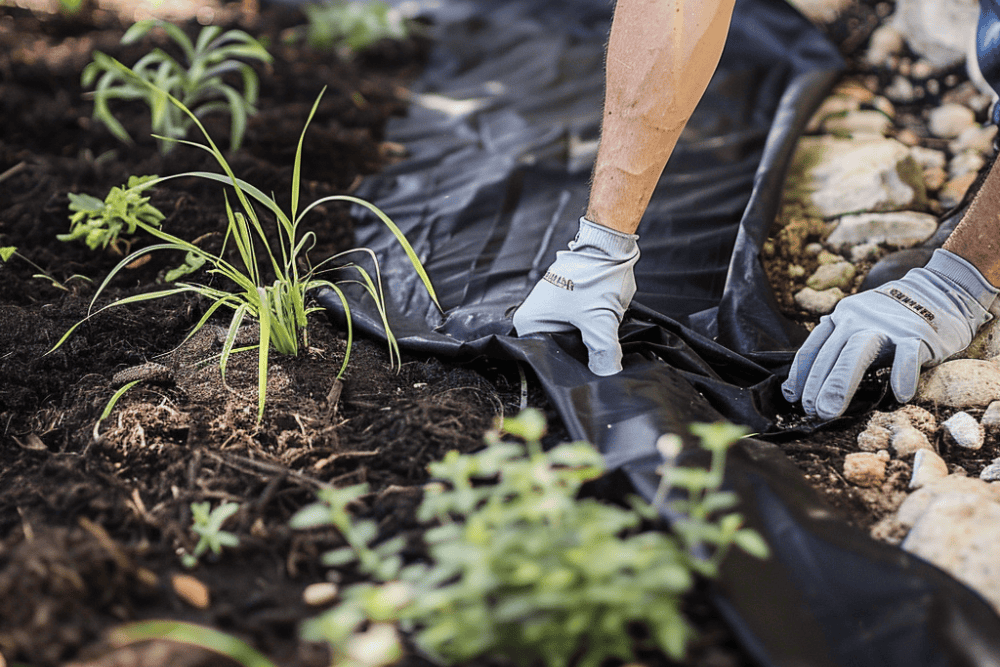Helping Plants by Suppressing Weeds and Retaining Moisture
Pros and Cons of Using Weed Control Fabric
Landscape fabric is a material used in gardens and landscapes to control weeds and improve plant growth. It simplifies much of your lawn care for your Denver area property. By keeping weeds at bay and preventing erosion, it makes your life as a homeowner a little bit easier.
There are several types of landscape fabric that we will explore in depth momentarily, for now here is a brief overview:
- Woven landscape fabric: Made from woven polypropylene or polyester, it provides a durable, long-lasting barrier and excels at stopping weeds.
- Non woven geotextile fabric: This type is usually made from bonded polypropylene fibers and is permeable and keeps weeds in checkk.
- Perforated landscape fabric: Features holes or perforations that permit soil and plants to access air and water while still blocking weeds.
Fabric pins can be used to secure landscape fabric in place, ensuring that it stays put and functions effectively.
Landscape fabrics vary in thickness and density, impacting their effectiveness and durability. Thicker fabrics provide more uv protection and are generally more durable.
Benefits of using landscape fabric include:
- Excellent physical barrier against weeds.
- Maintains soil moisture by reducing evaporation.
- Reduces the need for chemical weed killers, making it more eco-friendly.
- Controls erosion effectively on slopes or hilly areas.
Some fabrics are biodegradable, offering an environmentally friendly option.
Primary Uses of Landscaping Fabric

Weed Control is the #1 Function of Landscaping Fabric
Weed Control and Suppression
Landscaping fabric is an essential lawn care component that is most widely used for weed control. It acts as a weed barrier by blocking sunlight from reaching weed seeds. Without sunlight, the seeds can’t germinate and grow. Another benefit of being such an effective weed fabric is that it reduces the need for toxic weed killers.
To install, the fabric is laid over garden beds or pathways. Openings are cut for plants or shrubs. Once in place, it’s held down with metal stakes and usually covered with organic mulch or stones. This combination greatly helps in keeping weeds at bay and maintaining a clean look in the garden.
Soil Erosion Prevention
Landscape fabric also helps with erosion control. When water runs over bare soil, it can cause the soil to wash away. This is especially problematic after heavy rain or repeated watering.
Using landscape fabric helps stabilize the soil. Placing fabric under rock gardens, gravel/stone patios, or even turf grass areas can keep soil from shifting. This can be particularly useful on slopes or areas with loose soil. The fabric keeps the soil intact, thus preventing erosion and maintaining a stable garden structure.
Moisture Retention
Moisture retention is another benefit of using landscape fabric. By covering the soil, the fabric helps reduce evaporation. This means more water stays in the soil, benefiting plants that need constant moisture.
For example, plants in sandy soil often struggle with dryness. Landscaping fabric helps by trapping moisture and maintaining a more consistent soil environment. This is especially useful during hot summers when evaporation rates are high.
Integration with Garden Components
Landscape fabric is highly versatile and can be combined with various garden elements to enhance garden health and aesthetics. It supports mulch and plant life effectively when used correctly.

You Can Place Organic Mulch On Top of Landscaping Fabric to Increase Weed Suppression and Moisture Retention
Mulching Over Landscape Fabric
When applying mulch over landscape fabric, it acts as a barrier to keep the mulch in place and reduce weed growth. This combination is useful for flower beds, shrub areas, and vegetable gardens.
Placing mulch over the fabric helps retain soil moisture by reducing evaporation. This setup is particularly useful in trees and shrub areas where moisture retention is crucial.
Installation and Maintenance Tips
Proper Installation Techniques
When beginning a landscaping project with landscape fabric, ensure to measure and cut the fabric using a utility knife or scissors. This guarantees the fabric fits the designated area precisely. Overlapping fabric by about 6 inches helps prevent weeds from sneaking through gaps.
Securing the fabric is crucial; use garden staples or landscape pins placed every 2 feet along the edges. Depending on the size of the project, additional pins might be necessary to hold the fabric in place. Avoid dumping soil directly onto the fabric to prevent displacing it. Instead, use a wheelbarrow to transport soil. 
Placing Landscaping Fabric in a Garden
For planting, cut X-shaped holes where the plants will go. Fold back the flaps, dig the hole, and plant as needed. Lay the flaps snugly around the plant base after installation to keep the soil in place, assisting irrigation and reducing weeding efforts.
Long-Term Fabric Maintenance
Over time, landscape fabric can degrade, tear, or biodegrade, reducing its effectiveness. Regular checks are necessary for maintaining its condition. Inspect the fabric annually to find and replace rusty or broken garden staples.
As organic mulch decomposes, it should be removed and replaced to maintain the fabric‘s coverage and effectiveness. Keep an eye on the overall condition of the landscape fabric and replace sections that are worn out or damaged. Doing so ensures that the barrier continues to prevent weeds and supports the health of your garden plants.
Environmental Implications
One of the main concerns is its impact on soil health. Synthetic fabrics like non-woven and perforated materials can limit the movement of organic matter into the soil. This can reduce the availability of nutrients, which are important for plant growth.
Landscaping Fabric: Not Great Worms
The fabric can also affect earthworms and other soil organisms. These creatures need organic matter to thrive, and a barrier can make it harder for them to access food. This can decrease their population and the overall health of the soil.
Plastic Landscaping Problem Isn’t Environmentally Friendly
Plastic sheeting landscape fabrics, like those made from polypropylene, can act as an effective weed suppression mechanism, but it has downsides. Plastic contributes to plastic pollution if not disposed of properly. When they break down, they can release microplastics into the environment, contaminating soil and water sources and affecting wildlife.
On the positive side, permeable fabrics allow water to pass through, reducing water runoff and promoting better water management in the garden. They can also help prevent weed growth, which can reduce the need for chemical herbicides.

Plastic Landscaping Fabric Control Methods While Effective, Aren’t Great for Your Soil or the Enivornment
Using natural or eco-friendly alternatives like linen or jute can mitigate some negative impacts. These materials decompose more easily and do not contribute to pollution. While they may not last as long as synthetic options, they support a healthier garden bed ecosystem.
Material and Product Selection
Choosing the right landscape fabric involves understanding the types available and how each can meet specific needs. It’s essential to consider material, durability, and intended use.
Types of Landscape Fabric
There are four main types of landscape fabric: woven, non-woven, spun fabric, and perforated fabric.
Woven Landscape Fabric
Made from woven polypropylene or polyester, it provides a durable, long-lasting barrier. It’s your best option as a weed barrier and also provides erosion control benefits. It is durable and great for soil stabilization. Woven landscape fabric allows water and nutrients to reach the soil while blocking weed growth. It is made from polypropylene or polyester, known for durability and strength. Ideal for paths and under gravel/stone patios.
Non Woven Geotextile Fabric
This type is usually made from bonded polypropylene fibers. It is typically much thicker than woven fabric. Non woven landscape fabric allows moisture to pass through but keeps weeds out. Good for weed control, water permeability, and ease of use. Suitable for separating soil and mulch layers.
Perforated Landscape Fabric
Features holes or perforations within the fabric. A good choice for plants and garden areas to allow desired plants to thrive while stunting weed growth.
Spun Landscape Fabric
Spun landscape fabric – also known as spunbond landscape fabric – is a subset of nonwoven fabric made through a process called spunbonding. In this process, thermoplastic polymers (usually polypropylene) are melted and extruded through fine nozzles to create continuous filaments. These filaments are then laid down in a web-like structure and bonded together using heat, pressure, or chemical means to form a cohesive fabric.
Selecting the Right Fabric for Your Needs
Hardscape vs. Garden Areas
For heavy-duty use like under driveways or stone patios, non-woven is best and may be your best choice in, around, and underneath hardscape elements. Woven fabric works well for paths and general gardening.
Sun Exposure
In areas with high sunlight exposure, choose UV-resistant fabrics to prevent breakdown. Perforated fabrics are suitable where drainage is a concern.
Thickness vs Permeability
Thicker fabrics provide better weed control but may be less permeable. Balance between durability and permeability based on specific needs.
Generally speaking, you’re going to want to look for a fabric that balances air and water flow with weed prevention for the best results in your landscaping project.
Alternative Solutions and Comparisons
There are several alternatives to landscape fabric that offer unique benefits. These solutions often provide better weed control, sustainability, and soil health improvement.
Organic Mulches vs. Landscape Fabric
Organic mulches, like wood chips and bark mulch, are popular for their natural benefits. They retain moisture, regulate soil temperature, and enrich the soil as they decompose. For vegetable gardens, these options are particularly advantageous because they contribute nutrients that plants need. As mentioned earlier, you can combine both organic mulch and landscape fabric to get extra weed protection and water retention benefits.
Burlap & Compost
Burlap and compost can also serve as effective alternatives. Burlap is easy to install and decomposes over time, while compost adds essential nutrients to the soil, enhancing plant growth. Compost also breaks down but helps to enrich the soil. The only real downside to both burlap and compost is the fact that it will need to be more frequently replaced than landscape fabric.
Landscape Fabric vs. Ground Cover
Ground cover crops like clover, creeping thyme, vinca, or rye grass are another alternative to landscape fabric. They cover the soil, preventing weed growth and erosion. They also help to regulate the soil temperature by blocking out direct sunlight.
Check out our article on ground cover options for Colorado yards. Here, you can find native ground cover options that thrive in Colorado’s semi-arid environment.
Frequently Asked Questions
How does landscaping fabric benefit a garden?
Landscaping fabric helps in preventing weed growth by blocking sunlight. It also retains moisture in the soil, reducing the need for frequent watering. By doing so, the fabric supports healthier plant growth and reduces maintenance efforts.
What are the steps for properly using landscaping fabric in a vegetable garden?
Use and installation of landscaping fabric is fairly straightforward:
- Clear the area of weeds and debris.
- Lay the weed barrier fabric flat on the soil surface.
- Secure it with metal landscape pins.
- Cut holes where vegetable plants will be placed.
- Cover the fabric with mulch to add nutrients and protection.
What materials can be used as alternatives to traditional landscape fabric?
Alternatives to traditional landscape fabric include biodegradable options like cardboard or newspaper. Organic mulches such as wood chips and straw can also serve as effective weed barriers while adding nutrients to the soil.
What are the best practices for laying landscape fabric under gravel?
First, clear and level the area. Then, lay the fabric smoothly without wrinkles. Secure it with landscape pins to prevent shifting. Pour gravel evenly over the fabric to keep it in place. This method helps in preventing gravel from mixing with the soil.
What should be placed over landscape fabric to maximize its effectiveness?
To maximize effectiveness, place mulch or decorative stones over the landscape fabric. Mulch can help retain moisture and provide nutrients to the soil. Decorative stones add a polished look and further suppress weed growth.
What are the primary materials used in the manufacture of landscape fabric?
Landscape fabric is commonly made from woven or non-woven polypropylene. Woven fabrics are strong and durable, making them suitable for high-traffic areas. Non-woven fabrics are thicker and often used under heavy materials like stone pavers for added stability.
